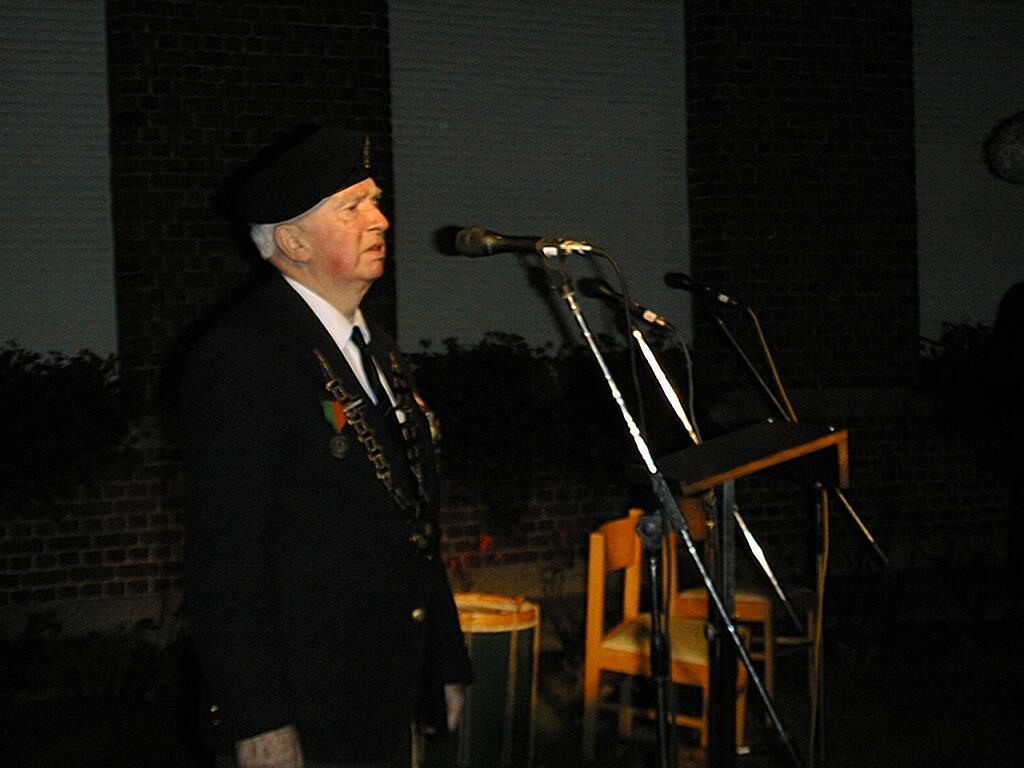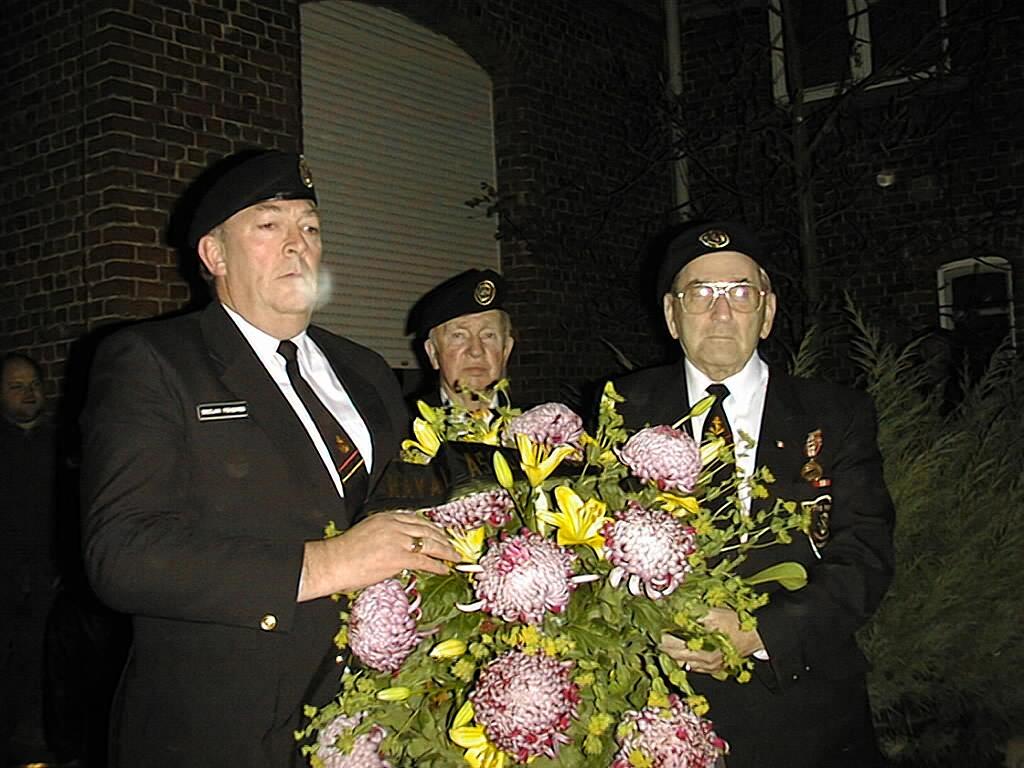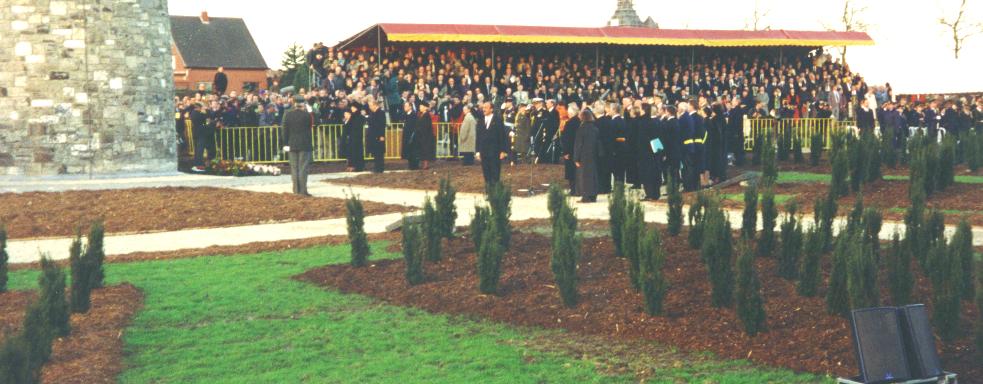|
Irish Naval Association visit the Western Front November 9th, 1998.
Major Redmond was a Nationalist MP in Ireland prior to heading off to the Western Front. On hearing of the Easter Rebellion in Ireland in 1916, he was very upset that the leaders of the Rising were executed. So much so, he left instructions that, should he be killed during the war, he did not want to be buried in a British cemetery. Mortally wounded, Major Redmond was taken to an Orphanage at Loker, not far from Messines. He died soon afterwards. Major Redmond, according to his wishes, was buried outside the walls of the British military cemetery at Loker. |
 |
|
The British War Graves Commission have offered, on several occasions, to re-intern Major Redmond, in the grave provided for him, within the walls of the military cemetery at Loker. His family still refuse this request, as they wish to comply with his dying wishes. The grave is looked after by local villagers. The local Pub in Loker is called "The Redmond". |
| Major Redmond's Grave (picture taken late in the evening 10/11/98) |
|
Following the ceremony at Loker, all in attendance were invited to a "feast" at Redmond's Pub. We were joined by our Irish Army colleagues from Collins Barracks, Cork, who were also invited to the ceremony.
Wednesday 11th November. (80th anniversary of the ending of WW1) A coach, with 41 members of the Irish Army from Collin's Barracks, Cork, together with the Naval Association in their coach, departed Lille and headed for the Last Post Ceremony at Ypres. This memorial is dedicated to all who died there, after their victories at Messines in July 1917. Both divisions, the 16th (Irish), and the 36th (Ulster), went on to fight at Passchendale near Ypres and were slaughtered. Theirs are amongst the 74,000 names on the memorial to the missing at Ypres. They drowned in mud, to tired to struggle to safety, or were blown to pieces by shell, or riddled by machine gun bullets. |

|
|
Members of the Irish Army from Cork, and The Naval Association, lay a wreath at the memorial to the Munster Regiments, outside St Martins's Cathedral, Ypres.
(the memorial by architect T.A. O'Connell was a tribute from the City of Cork, Ireland)
Following the Last Post ceremony at 11am at the Menin Gate, we headed off to Messines. On arrival at the entrance to the Peace Park, we were escorted to our seats in stand E. We could not have asked for better seating and all had an excellent view of the proceedings. It was both a moving and historic occasion as we watched British and Irish dignitaries arrive for the ceremony. Great credit is due to Paddy Harte, from the Republic of Ireland, and Glen Barr, from the North of Ireland, who were jointly responsible for this great event.
The Irish Peace Park and Round Tower dedicated to the Irish who fought and died during WW1. These men have long been forgotten throughout most of the Republic of Ireland. Until now!! Everyone present felt a sense of emotion at the sight of the Irish and British Army working together at the ceremony. The joint Military Bands from Ireland and Britain marched together into the Peace Park, and performed under the baton of Comdt. Joe Ryan, the Irish Army Musical Director.The icing on the cake was the arrival of Queen Elizabeth ll of the United Kingdom, together with the King and Queen of Belgium, who came to witness the Inauguration of the Round Tower, by the Irish President, Mary McAleese. The Tower and Peace Park are dedicated to the men of the 10th (Irish),16th (Irish) and 36th (Ulster) Divisions who fought during WW1. It was at Messines Ridge in July 1917 that one of the few early victories of the war was gained. Messines Ridge was a vital stronghold held by the Germans since 1914. This ridge overlooked the town of Ypres with a very clear view of the surrounding area. It was important to the Allies that this ridge be taken at all cost, if the stalemate of the trench warefare was to be broken. 20 deep tunnels had been dug under this ridge which took 18 months to complete. Each tunnel was packed with high explosives. On the morning of 1st June 1917 the tunnels with 1,700,000 Lbs of high explosives were detonated under the Germans. This was followed by an attack by both the 16th (Irish) and 36th (Ulster) Divisions, who, for the first time, fought and died together, side by side, all problems in Ireland left to one side.
See also more details of the Tower
|
 The President of the Naval Association, Piaras O'Connor, accompanied by Angela, scatter her husband's
ashes onto the Irish Sea.
The President of the Naval Association, Piaras O'Connor, accompanied by Angela, scatter her husband's
ashes onto the Irish Sea.





